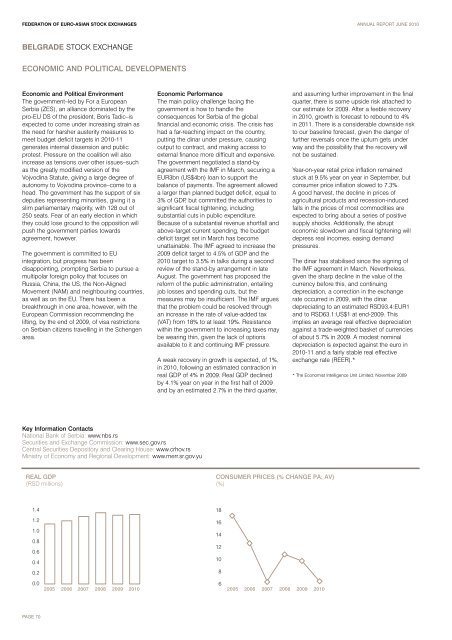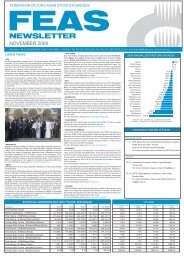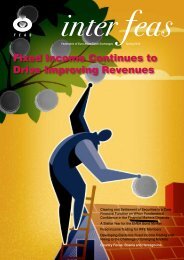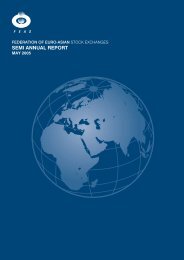Download - FEAS
Download - FEAS
Download - FEAS
- No tags were found...
You also want an ePaper? Increase the reach of your titles
YUMPU automatically turns print PDFs into web optimized ePapers that Google loves.
FEDERATION OF EURO-ASIAN STOCK EXCHANGES ANNUAL REPORT JUNE 2010BELGRADE STOCK EXCHANGEECONOMIC AND POLITICAL DEVELOPMENTSEconomic and Political EnvironmentThe government–led by For a EuropeanSerbia (ZES), an alliance dominated by thepro-EU DS of the president, Boris Tadic–isexpected to come under increasing strain asthe need for harsher austerity measures tomeet budget deficit targets in 2010-11generates internal dissension and publicprotest. Pressure on the coalition will alsoincrease as tensions over other issues–suchas the greatly modified version of theVojvodina Statute, giving a large degree ofautonomy to Vojvodina province–come to ahead. The government has the support of sixdeputies representing minorities, giving it aslim parliamentary majority, with 128 out of250 seats. Fear of an early election in whichthey could lose ground to the opposition willpush the government parties towardsagreement, however.The government is committed to EUintegration, but progress has beendisappointing, prompting Serbia to pursue amultipolar foreign policy that focuses onRussia, China, the US, the Non-AlignedMovement (NAM) and neighbouring countries,as well as on the EU. There has been abreakthrough in one area, however, with theEuropean Commission recommending thelifting, by the end of 2009, of visa restrictionson Serbian citizens travelling in the Schengenarea.Economic PerformanceThe main policy challenge facing thegovernment is how to handle theconsequences for Serbia of the globalfinancial and economic crisis. The crisis hashad a far-reaching impact on the country,putting the dinar under pressure, causingoutput to contract, and making access toexternal finance more difficult and expensive.The government negotiated a stand-byagreement with the IMF in March, securing aEUR3bn (US$4bn) loan to support thebalance of payments. The agreement alloweda larger than planned budget deficit, equal to3% of GDP, but committed the authorities tosignificant fiscal tightening, includingsubstantial cuts in public expenditure.Because of a substantial revenue shortfall andabove-target current spending, the budgetdeficit target set in March has becomeunattainable. The IMF agreed to increase the2009 deficit target to 4.5% of GDP and the2010 target to 3.5% in talks during a secondreview of the stand-by arrangement in lateAugust. The government has proposed thereform of the public administration, entailingjob losses and spending cuts, but themeasures may be insufficient. The IMF arguesthat the problem could be resolved throughan increase in the rate of value-added tax(VAT) from 18% to at least 19%. Resistancewithin the government to increasing taxes maybe wearing thin, given the lack of optionsavailable to it and continuing IMF pressure.A weak recovery in growth is expected, of 1%,in 2010, following an estimated contraction inreal GDP of 4% in 2009. Real GDP declinedby 4.1% year on year in the first half of 2009and by an estimated 2.7% in the third quarter,and assuming further improvement in the finalquarter, there is some upside risk attached toour estimate for 2009. After a feeble recoveryin 2010, growth is forecast to rebound to 4%in 2011. There is a considerable downside riskto our baseline forecast, given the danger offurther reversals once the upturn gets underway and the possibility that the recovery willnot be sustained.Year-on-year retail price inflation remainedstuck at 9.5% year on year in September, butconsumer price inflation slowed to 7.3%.A good harvest, the decline in prices ofagricultural products and recession-inducedfalls in the prices of most commodities areexpected to bring about a series of positivesupply shocks. Additionally, the abrupteconomic slowdown and fiscal tightening willdepress real incomes, easing demandpressures.The dinar has stabilised since the signing ofthe IMF agreement in March. Nevertheless,given the sharp decline in the value of thecurrency before this, and continuingdepreciation, a correction in the exchangerate occurred in 2009, with the dinardepreciating to an estimated RSD93.4:EUR1and to RSD63.1:US$1 at end-2009. Thisimplies an average real effective depreciationagainst a trade-weighted basket of currenciesof about 5.7% in 2009. A modest nominaldepreciation is expected against the euro in2010-11 and a fairly stable real effectiveexchange rate (REER).** The Economist Intelligence Unit Limited, November 2009Key Information ContactsNational Bank of Serbia: www.nbs.rsSecurities and Exchange Commission: www.sec.gov.rsCentral Securities Depository and Clearing House: www.crhov.rsMinistry of Economy and Regional Development: www.merr.sr.gov.yuREAL GDP(RSD millions)CONSUMER PRICES (% CHANGE PA; AV)(%)1.4181.2161.0140.8120.60.4100.280.062005 2006 2007 2008 2009 2010 2005 2006 2007 2008 2009 2010PAGE 70
















